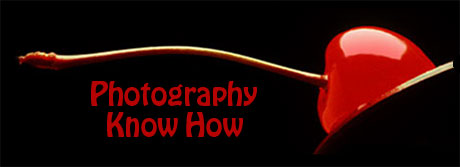In this photography lecture we’ll discuss camera shutter speeds. The shutter speed is one of the controls that determines the exact amount of exposure your film or image sensor receives.
Shutter speed controls the time of an exposure by controlling exactly how long the aperture remains open. The shutter speed also has other effects on your pictures which will be covered as well.
The following is a list of the full shutter speeds, starting with 1 second:
1, 1/2, 1/4, 1/8, 1/15, 1/30, 1/60, 1/125, 1/250, 1/500, 1/1000, etc.
Each of the above shutter speeds is 1/2 the amount of time as the previous speed.
Many cameras have speeds that are longer than 1 second and shorter than 1/1000 of a second.
The above speeds are a carry over from the days before digital, so you’ll notice that 1/16 has been rounded down to 1/15. With digital the sequence is more commonly 1/16, 1/32, 1/64, etc. And with many modern shutters, speeds of any duration are possible…for example you may get 1/650 or 1/1200 of a second.
The shutter speeds listed above are set up similar to f-stops…each speed lets in 1/2 as much light as the previous speed, and twice as much as the next one.
This allows for a different combination of shutter speed and f-stop to be chosen to get the same exact exposure. So 1/60 at f/8 gives the same exposure as 1/30 at f/11, or 1/125 at f/5.6. The shorter the time (shutter speed) you use, the larger the aperture opening (f-stop) you’ll need to let in the same amount of light.
This can be confusing until you get used to it but with practice is becomes second nature.
A good analogy is to think of filling a container with water. If a 1 inch hose takes an hour to fill the container, then a 2 inch hose would take a half hour, a 4 inch hose would take 15 minutes, and so forth.
Each time you double the amount of water flowing in, it takes only half the amount of time to fill your container. It works the same way with f-stops and shutter speeds…a larger aperture lets in more light, so a faster shutter speed (less time) is needed.
Why so many combinations?
Well, exposure is controlled by a combination of f-stop and shutter speed, but each has another effect on the image as well. The depth of field is affected by the f-stop and sharpness is affected by the shutter speed. Depth of field is covered in another lecture, so here we will discuss how different shutter speeds affect sharpness.
Two common reasons for a lack of sharpness in photographs both have to do with movement…. one is subject movement and the other is camera movement (or camera shake as it is often referred to).
Subject movement is of course when you are taking a picture of a moving object. If your purpose is to freeze the motion and render the subject very sharp, then you would want a fast shutter speed.
On the other hand, you may wish to emphasize the motion so a slower shutter speed would be the better choice.
Camera movement is the other common reason for unsharp images. There can be several causes of camera movement. One is pressing the shutter release too hard causing the camera to jerk at the exact moment of exposure. Even a fast shutter speed may not be able to correct this habit. It just takes practice.
What shutter speed is fast enough to avoid camera movement will vary due to a number of factors.
First, it will depend on how steady you are when holding your camera. Again, practice can help. And using a faster shutter speed whenever possible is a good solution. Remember also when you are using a longer lens (a telephoto) that not only is the size of the image magnified, but the movement is magnified as well.
So with longer lenses a faster shutter speed may be needed to avoid camera movement. If you must use a slower speed then try to brace yourself and/or your camera or use a tripod or firm surface like a table, a wall or a tree to help steady the camera.
The main point with camera movement is to be aware of it and practice those things that work to help you keep steady when you make the exposure.
Related Topics




[…] Shutter Speed : A shutter controls the time of an exposure. The shutter speed controls the exact length of time that the image sensor is exposed to the light coming into the camera. […]